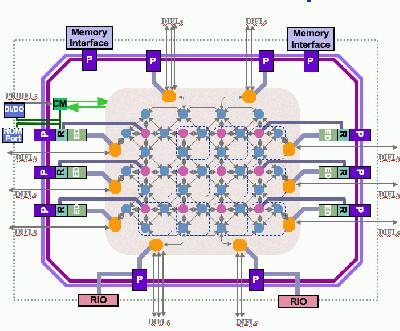
MONARCH: the architecture is flexible
A revolutionary processor package that changes its architecture to adapt to the demands of different computing tasks more than met design expectations in recent trials.
Near-term applications for the MONARCH (Morphable Networked Micro-Architecture) system designed by the USC Information Sciences Institute and Raytheon include space radar and video processing, which require small size and low power.Raytheon also is investigating high-end commercial applications such as use in smart cars and highways and in medical imaging, as well as exploring a method for countering GPS jamming for the military.
During Phases I and II of the program, an ISI group headed by John Granacki developed the MONARCH architecture, working with the Advanced Concepts and Technology group of Raytheon Space and Airborne Systems on a contract from DARPA.
Granacki (below left) is director of the Advanced Systems Division at ISI, and Research Associate Professor of Electrical Engineering Systems and Biomedical Engineering in the USC Viterbi School of Engineering.
 “What we have been creating is essentially a supercomputer on a chip,” he said, “and not just a supercomputer, but a flexible supercomputer that reconfigures itself into the optimal supercomputer for each specific part of a multi-part task.”
“What we have been creating is essentially a supercomputer on a chip,” he said, “and not just a supercomputer, but a flexible supercomputer that reconfigures itself into the optimal supercomputer for each specific part of a multi-part task.”
This flexibility means MONARCH allows a significant reduction of the amount of hardware (and therefore power) required for computing systems, while still achieving extremely high (teraflop) throughput. Because of the memory integrated on the chip, very small systems may be implemented with only a single MONARCH device. For larger implementations, hardware demand is further reduced by MONARCH’s ability to “morph” devices to so they can perform downstream tasks instead of sitting idle while waiting for fresh input

The MONARCH chip (see specifications, right) may also serve as a system building block, allowing systems of different sizes to be based on arrays of devices. Each device has input/output ports to enable seamless data movement among multiple chips. The device has two off-chip memory interfaces for large problems. Finally, every chip is equipped with two RapidIO interfaces for connecting to industry-standard equipment.
According to Granacki, MONARCH’s polymorphic capability and super efficiency enable the development of DoD systems that need very small size, low power, and in some cases (particularly systems to be used in space) radiation tolerance.
Working with Granacki at ISI on MONARCH team were ISI Project Leaders Jeff LaCoss and Jeff Draper. Draper’s team of four graduate students (Sumit Mediratta, Taek-Jun Kwon, Rashed Bhatti, and Greg Lou) and two engineers (Tim Barrett, Jeff Sondeen) contributed to significant parts of the chip implementation.
Draper noted, “At the time of its implementation, the MONARCH chip was the largest standard- menu ASIC that IBM had ever built in 90nm technology.” The chip measures close to 19mm on a side and contains over 1.5 kilometers of wiring. Draper’s team designed and implemented the RISC processors, network-on-chip routers (called PBufs), floating-point units in the arithmetic clusters, the Flash interface, and embedded DRAM controllers. “Typically, a chip is optimally designed either for front-end signal processing or back-end control and data processing,” explained Nick Uros, vice president for the Advanced Concepts and Technology group of Raytheon Space and Airborne Systems.
“The MONARCH micro-architecture is unique in its ability to reconfigure itself to optimize processing on the fly. MONARCH provides exceptional compute capacity and highly flexible data bandwidth capability with beyond state-of-the- art power efficiency, and it’s fully programmable,” Uros added.
In preliminary tests in the Phase III evaluation, a prototype system consisting of just one of the new devices provided sustained throughput of 64 gigaflops (floating point operations per second) with more than 60 gigabytes per second of memory bandwidth and more than 43 gigabytes per second of off-chip data bandwidth.
In power-efficiency “MONARCH outperformed the Intel quad-core Xeon chip by a factor of 10,” said Michael Vahey, Raytheon’s principal investigator for the project.
Besides USC, subcontracting team members included Craig Steele of Exogi, Inc., Sudhakar Yalamanchili of Georgia Tech, and James Kulp of Mercury Computer Corporation Georgia Institute of Technology, Mercury Computer Systems and IBM’s Global Engineering Solutions division.
Published on March 22nd, 2007
Last updated on August 6th, 2021













